5. Let’s Talk about Stress
Stress is an unavoidable part of post-secondary student life, but it isn’t necessarily a bad thing. This section helps participants rethink stress and consider how it can help them. It also uses the Wellness Wheel to examine healthy ways to cope with stress.
These slides are available for use with this section of the presentation. For information about downloading the slide deck, see the Introduction.
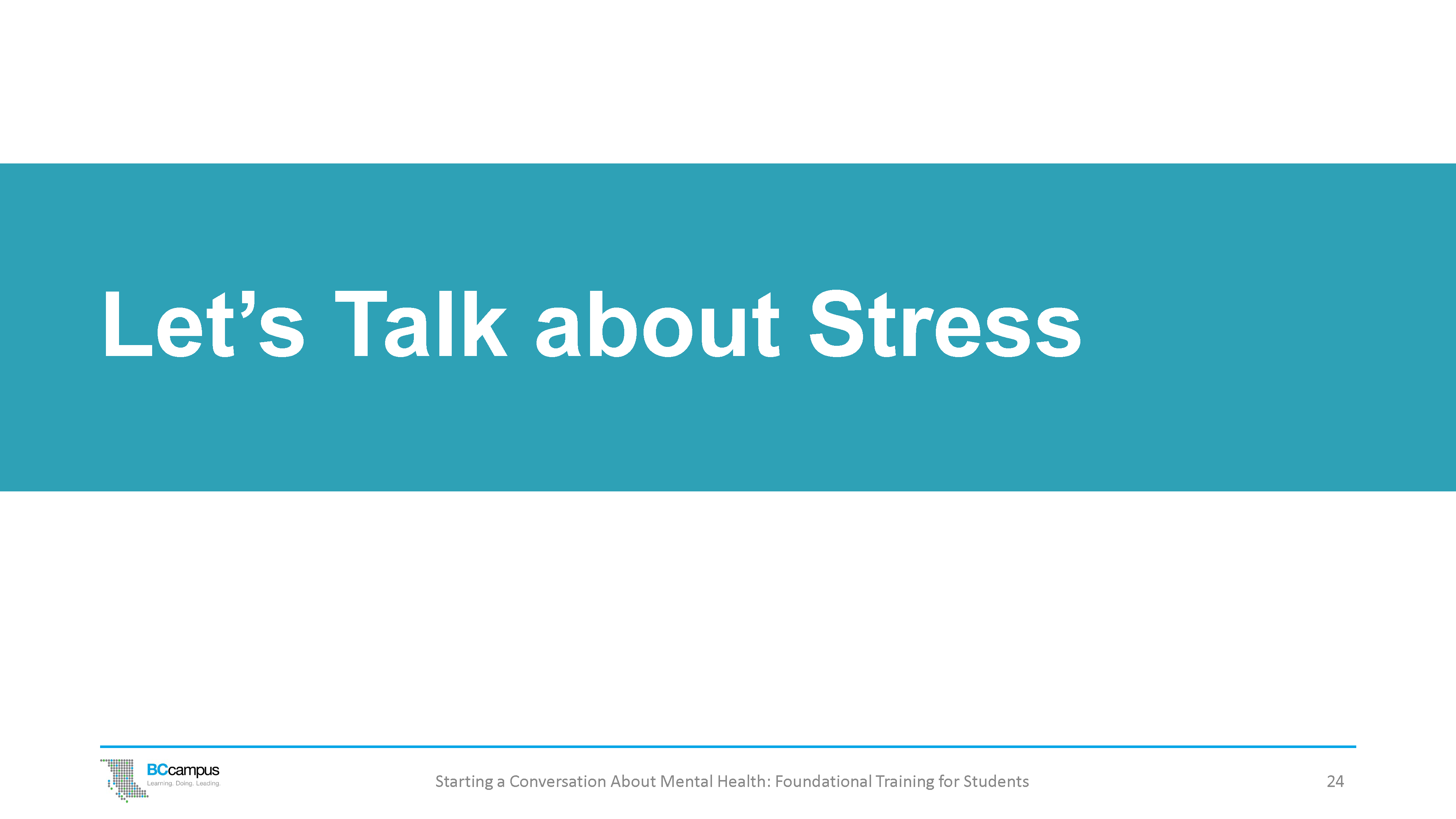
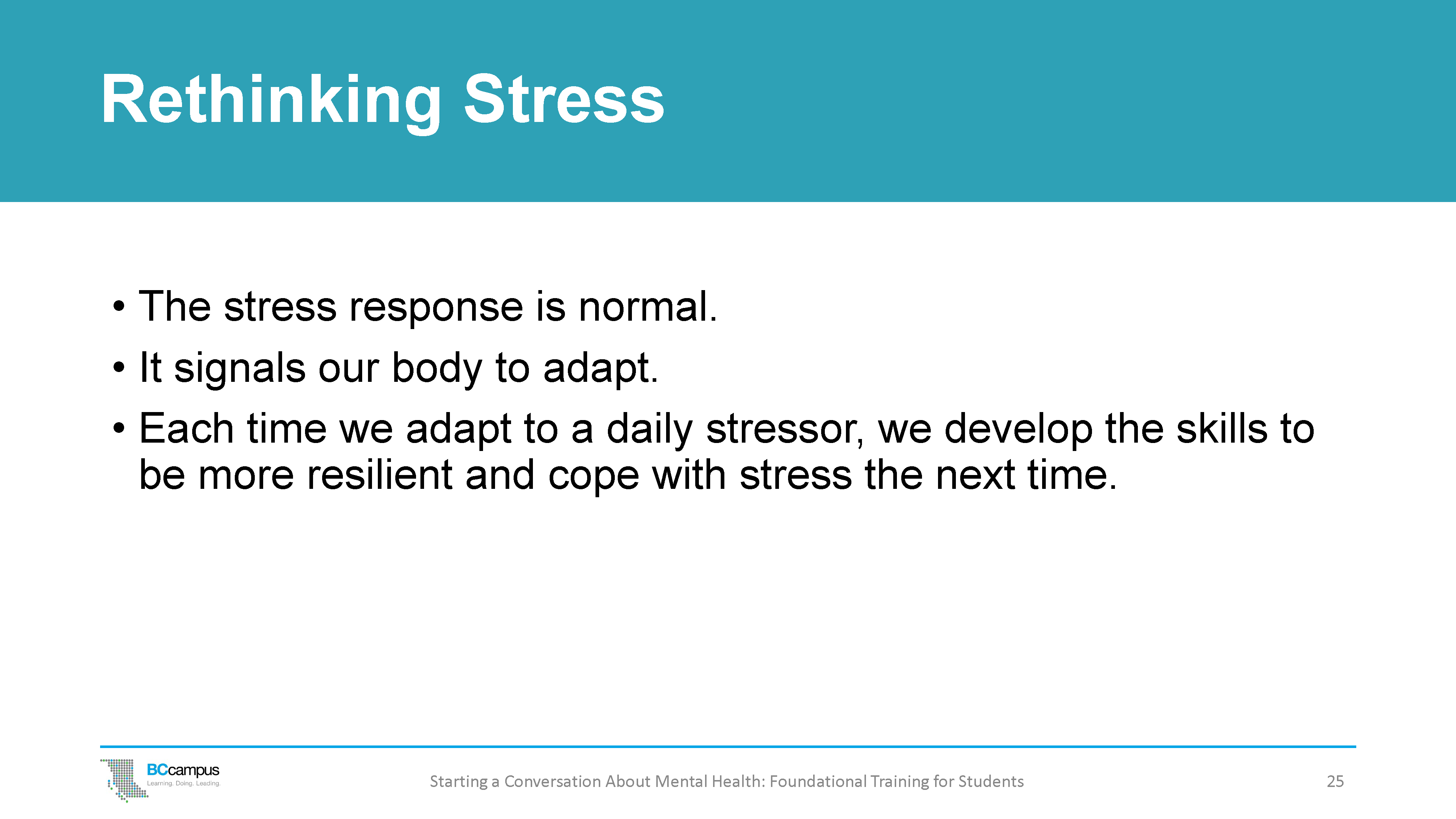
One of the most common challenges students face is stress. While stress and mental distress is part of the human experience, and definitely part of the post-secondary experience, people cope differently with stress, depending on their background, environment, relationships, and specific circumstances (e.g., living with an illness). In similar situations, two people may experience stress differently.
Rethinking Stress
You need to take on reasonable challenges to help condition your brain for responding to stressors in order to become more resilient.
The stress response is a response that your body can use to prepare you for a challenge. As post-secondary students, it’s important to remember that you are here to learn and to grow, and with that comes challenges. If you experience the stress response as an opportunity to adapt, you can make stress work for you and help support your growth and resilience.
Remember:
- Stress is part of the post-secondary experience.
- The stress response is normal. It signals our body to adapt.
- Each time we adapt to a daily stressor, we develop the skills to be more resilient and cope with stress the next time.
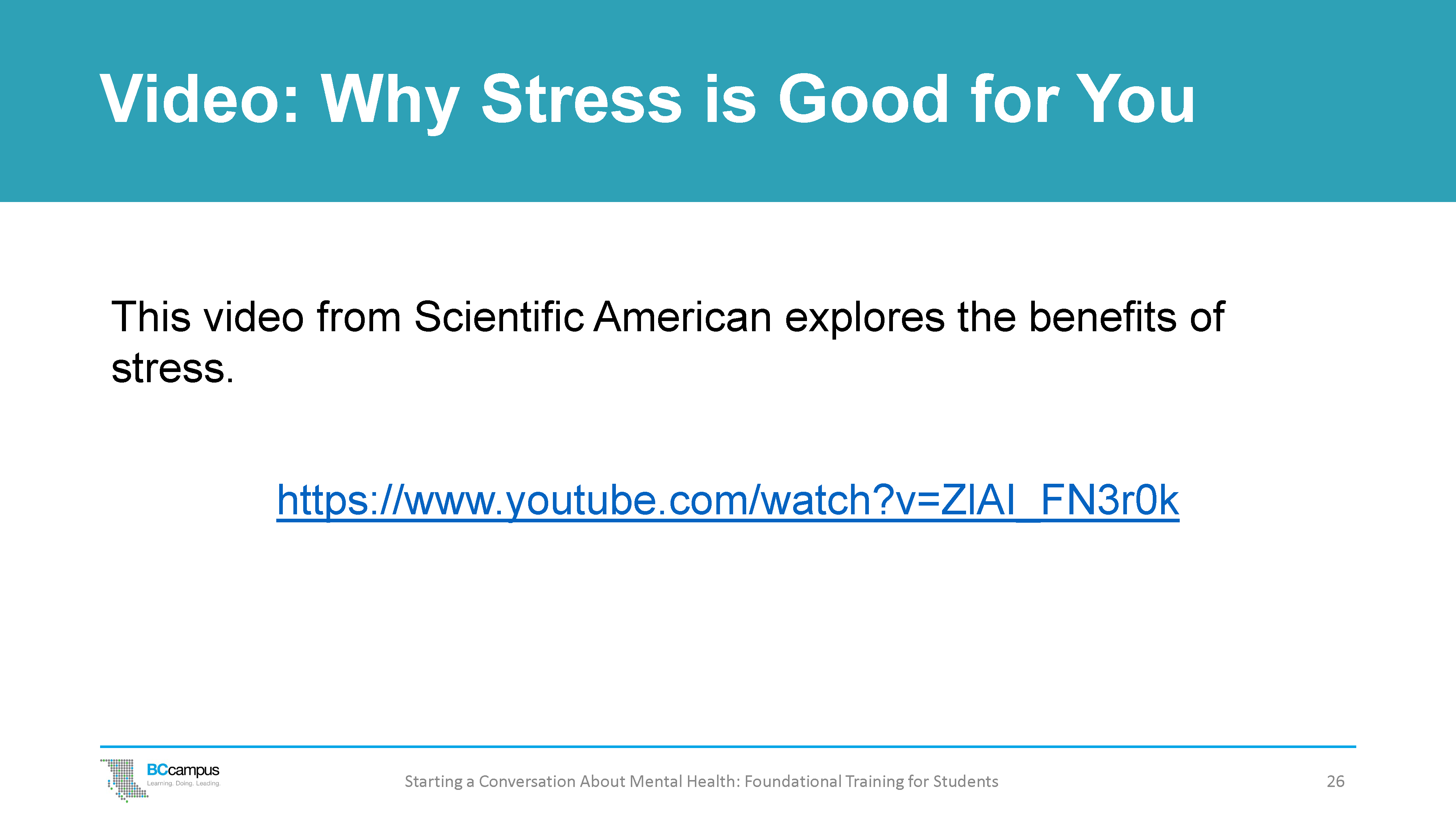
Video: Why Stress Is Good for You (2:32 min.)
This short video from Scientific American shows how stress can be viewed as helpful. (Show the video or share the link in chat): Why Stress Is Good for You.
In speaking about adapting when experiencing the stress response, we can think about ways to solve problems, try something new, or seek support. For example, you might feel stressed about starting classes online. Initially, you can acknowledge that, yes, this is a concern, then you can then move on to planning your time/schedule, setting up your work space, connecting with your classmates, and so on. Once you put this into effect, you’ve developed a new skill that can be applied to other scenarios.
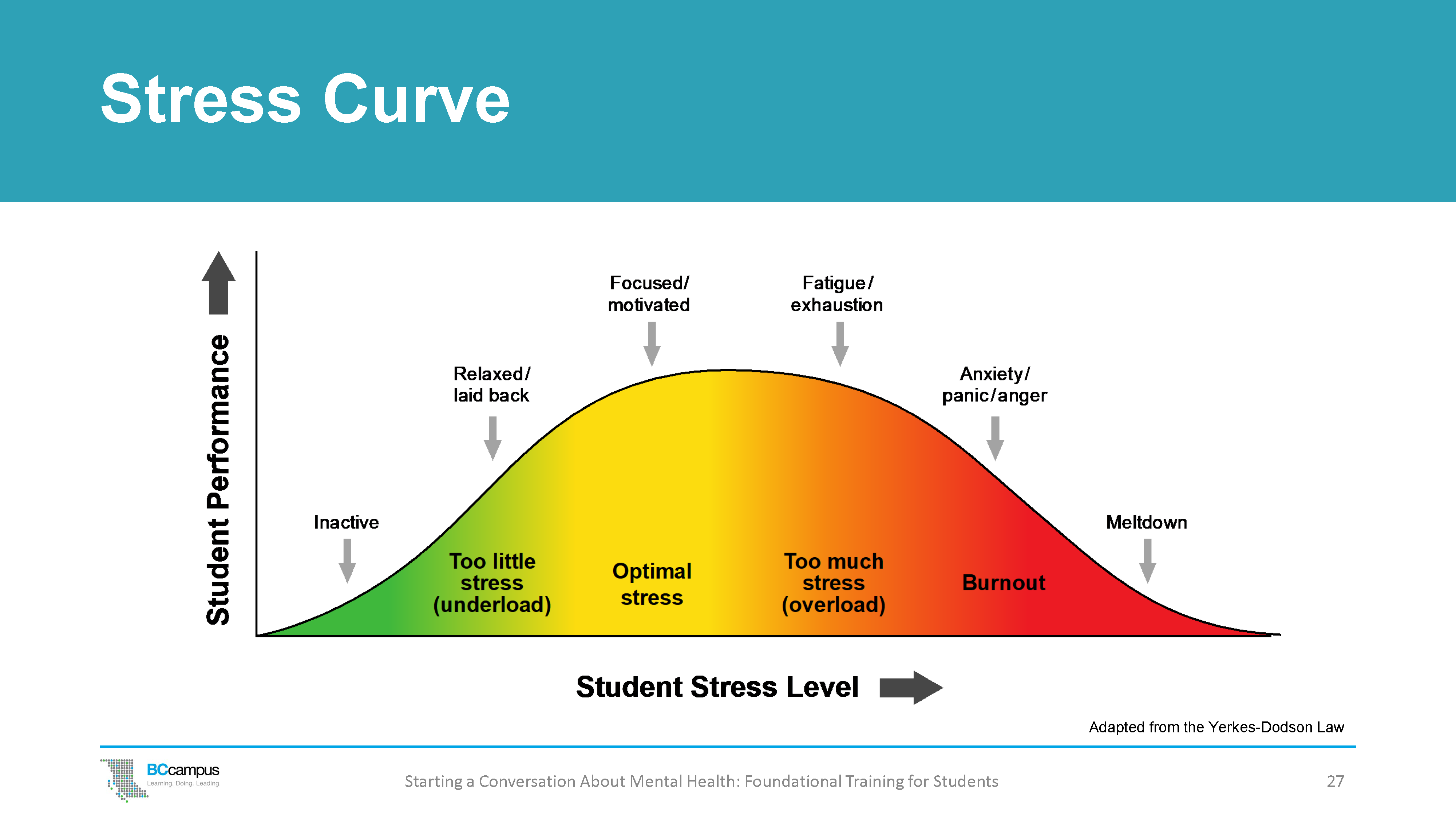
The Stress Curve
The Stress Curve shows that small amounts of stress help increase our alertness and energy for meeting challenging situations, but if stress lasts a long time or overwhelms our ability to cope, it can have negative effects.
The curve demonstrates that when performance demands are too low, we become bored and inactive. But as performance demands increase, our physiology kicks in and we start to feel alert and focused. We are motivated and we feel capable of dealing with the demands of life. However, when performance demands become too high – or we have become exposed to too many demands over a prolonged period – we become fatigued and experience a cascade of stress hormones that can wear us down. This can lead to problems with health, relationships, and work, and can affect our general enjoyment of life. Prolonged stress can often lead to burnout, serious illness, or mental health problems.

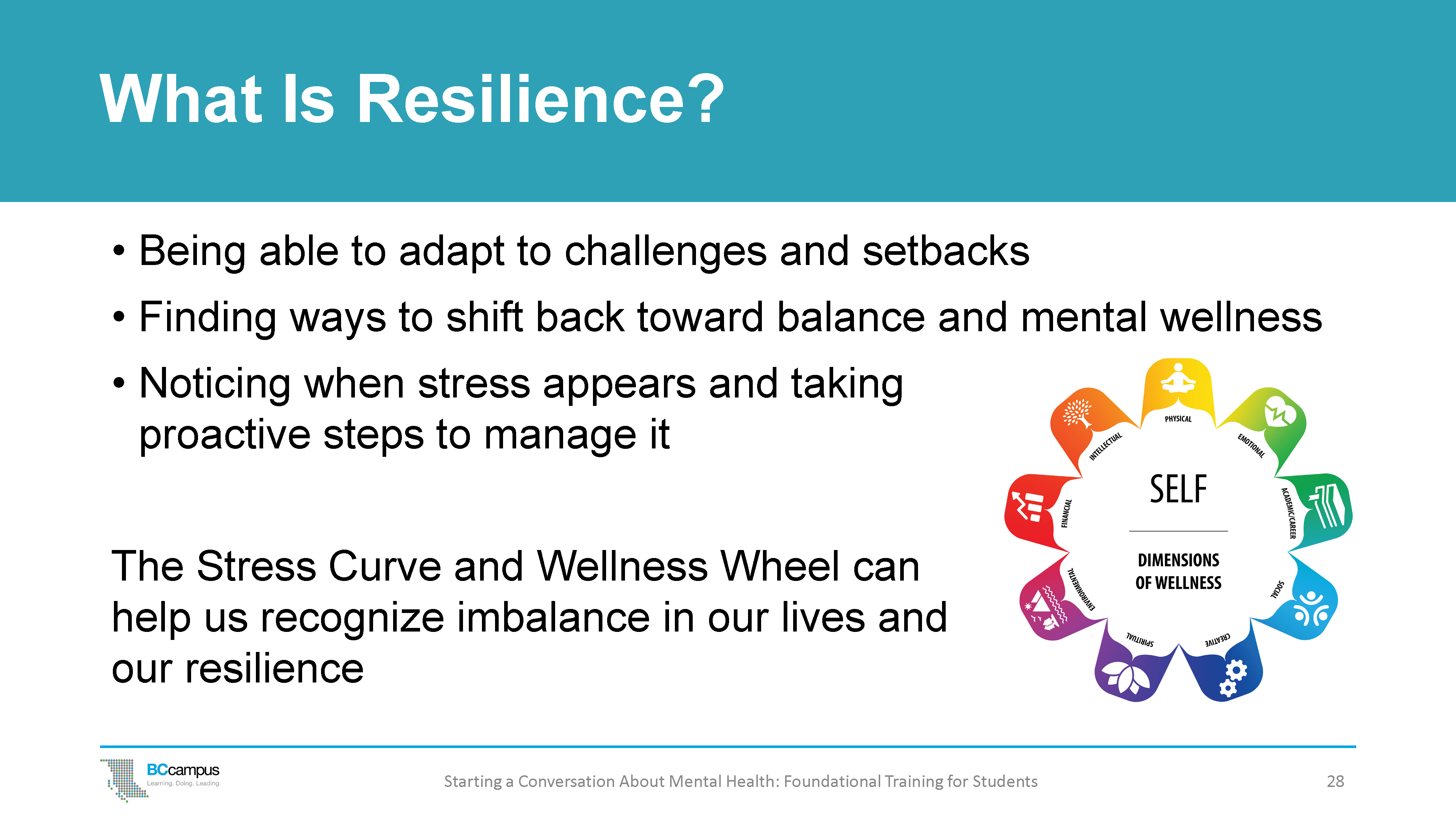
Resilience
Resilience is about being able to adapt to life’s challenges and setbacks. When something is out of balance in our lives or we’re experiencing stress, resilience helps us to shift back toward balance and mental wellness. It’s the ability to adapt to difficult situations, and it can help protect us from mental health problems. Resilience isn’t about avoiding or ignoring challenges in life; rather, it’s noticing when stress appears and taking proactive steps to manage the stress and pressure.
The Stress Curve helps us recognize that some stress can be a good thing. The Wellness Wheel, which we discussed earlier, can help us recognize what might be causing stress or pressure in our lives. It also reminds us of our own resilience and strengths; while we may be struggling in one area, we may be doing well in many other areas.
Traditional Healing Practices
In many Indigenous cultures across Turtle Island (what we now call North America), Indigenous Peoples have used natural resources as a source of healing and ceremonial medicine since time began. These traditional healing practices are ways many Indigenous people restore balance and build resilience.
Below is one perspective on maintaining balance and wellness from Kwakwa̱ka̱’wakw culture. You can share this with your participants or consider reaching out to Indigenous Elders or Knowledge Keepers in your community to learn more about local traditional healing practices that you could share with participants.
In my culture, we use the roots of a yarrow plant steeped in hot water to make tea to soothe stomach aches, headaches, colds, and diarrhea. We steam cedar branches in a pot on the stove to help with respiratory distress. We burn sage to smudge and cleanse ourselves, our space, or items of negative energies or spirits. When we have painful or negative emotions or when grief, sadness, or loss overwhelms us, we are taught to go back to the land, to go back to the water, to reconnect with the universe’s life force. Doing this through ceremony can be simple or elaborate; we can do this in private or within a trusted community.
One way we refer to these medicines is as helpers. Water is a common helper many people use, going to a natural body of water and submerging themselves entirely so the water cleanses them head to toe. If you do not have access to natural bodies of water, stand in the shower – not a bath that you soak in, but a shower to let the water run over you. This can be a time to speak to your helper and share with it your burdens; tell it what is weighing you down and ask for the help you need, allowing all the negativity to flow off you with the water. End with words of gratitude for the support of that helper.
As each Indigenous community has its own sacred connections to its territory and the medicines and plants that thrive there, we encourage you to seek out Knowledge Keepers in your area to learn more. Observe protocol by approaching the Elder or Knowledge Keeper with deep respect and an offering of tobacco (loose tobacco as it comes in the pouch from any general store is sufficient) while asking them to share with you what their traditional helpers may be. Not all ceremonial or cultural knowledge can be shared freely with people outside the community, as some sacred knowledge is kept for the community alone. But what can be shared will be shared with a good heart, as it helps all peoples come together in harmony.
—Jewell Gillies (Musgamagw Dzawada’enuxw of the Kwakwa̱ka̱’wakw Nation – Ukwana’lis, Kingcome Inlet, B.C.)
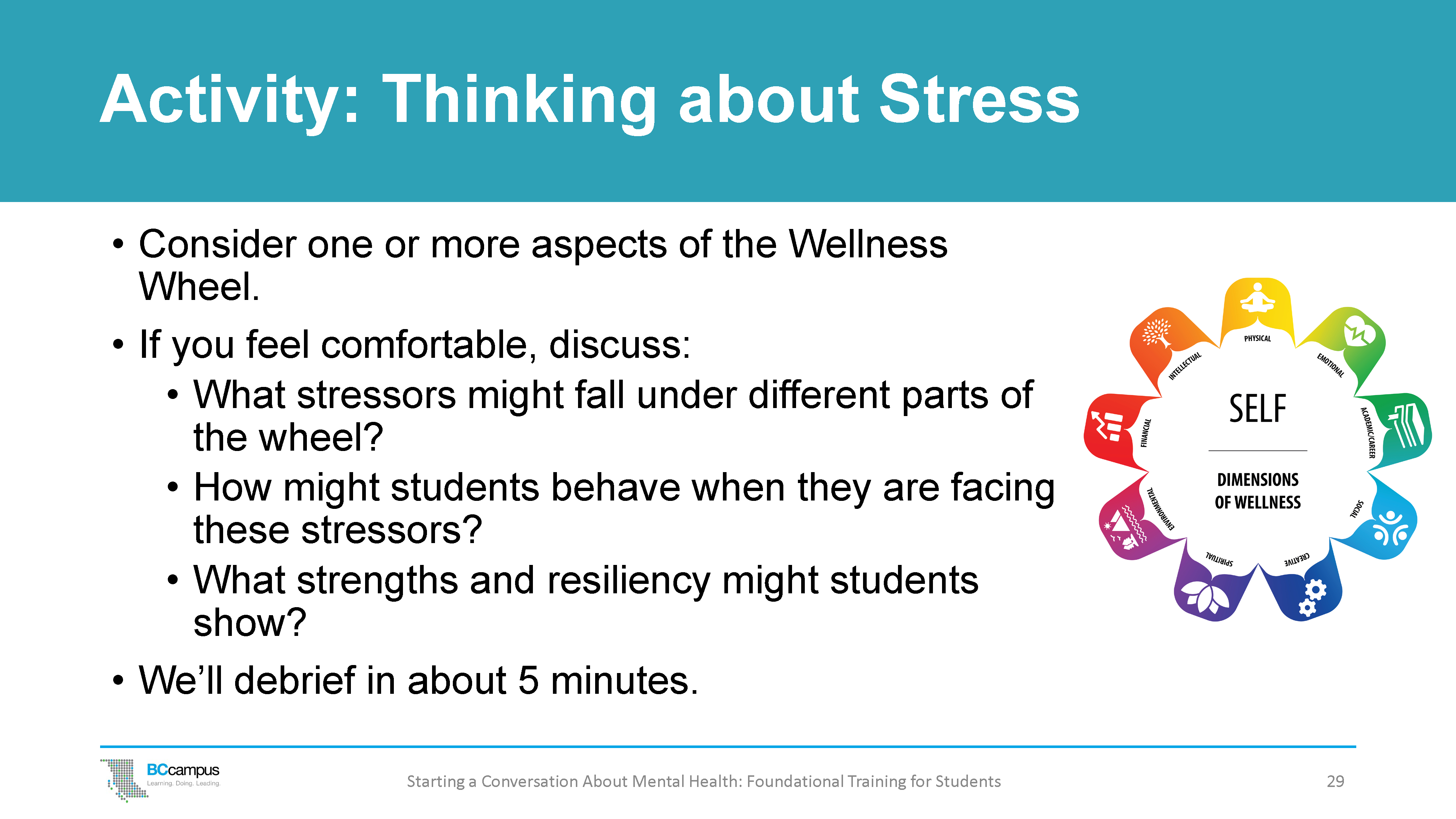
ACTIVITY: Thinking about Stress
Divide participants into small groups and ask each group to examine the Wellness Wheel and discuss the following:
- What stressors might fall under different parts of the wheel?
- How might students behave when they are facing these stressors?
- What strengths and resilience might students show?
Ask participants to also look at the Stress Curve to determine where various stressors might fit.
After about five minutes, debrief with the group. Some common stressors include:
- Moving
- Adjusting to university
- Exams
- Financial pressure
- Difficulty finding child care
- Breaking up with a partner or arguing with a friend
- Loneliness or isolation
- Job interview
Text Attribution
- This chapter was adapted from Mental Health Literacy for Student Leaders © UBC Student Health and Wellbeing staff (CC BY 4.0 License).
- “Traditional Healing Practices” by Jewell Gilles (CC BY 4.0 License).
Media Attributions
- Why Stress Is Good for You – Instant Egghead #40 by Scientific American. Standard YouTube License.
- Stress Curve © BCcampus is used under a CC BY 4.0 License. Adapted from Yerkes-Dodson Law (1908).

